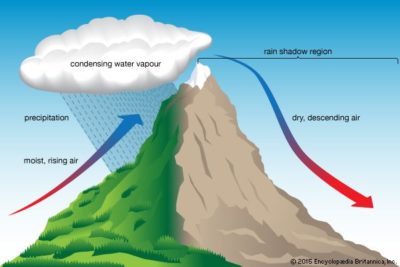
There are two sides to a coin. Heads or Tails. One coin, two different sides. Now shift your thoughts from a coin to a mountain or an island. Perhaps even a mountainous island. Think of the coin. Think of the island. In meteorology, the study of earth’s atmosphere, there are two sides to any island—the windward side and the leeward side.
The Windward Side
This is the colder, wetter side of an island. It is subject to consistent winds that blow cool, moist air upward. As this air is lifted, due to a decrease in atmospheric pressure, it begins to cool (scientifically called adiabatic cooling). Cooler air is not able to hold as much water vapor as warm air, so at some point the moisture in the air begins to condense and clouds form. Rain.
The Leeward Side
As condensation occurs, it releases heat into the surrounding air. This effect is called latent heat of condensation. By the time the air descends down the other side of an island (or mountain), most of its moisture has been condensed out. As the air continues to descend towards sea level, atmospheric pressure increases which causes a temperature increase. Because of all of this (scientifically called adiabatic warming), the leeward side is generally warmer and drier.
Why Does This Matter?
Climate is a significant driving factor in the creation and sustainability of ecosystems and habitats. The prevalence of rain on windward sides of islands promotes the growth of vegetation whereas the leeward side flora is acclimated to a drier climate. Catalina island is no exception to this rule. The backside of Catalina, which faces open ocean is considered the windward side. The side that faces the mainland is the leeward. Studies are being done to better understand the effect that orographic effect has on micro-habitats. The iconic kelp forest, for one.
For more reading: https://www.climate.gov/
Image Sources: https://www.britannica.com/science/rain-shadow


